Global Non Opioid Pain Treatment Market Size and Trends
Global non opioid pain treatment market is estimated to be valued at USD 85.84 billion in 2025 and is expected to reach USD 155.01 billion by 2032, growing at a compound annual growth rate (CAGR) of 8.6% from 2025 to 2032.
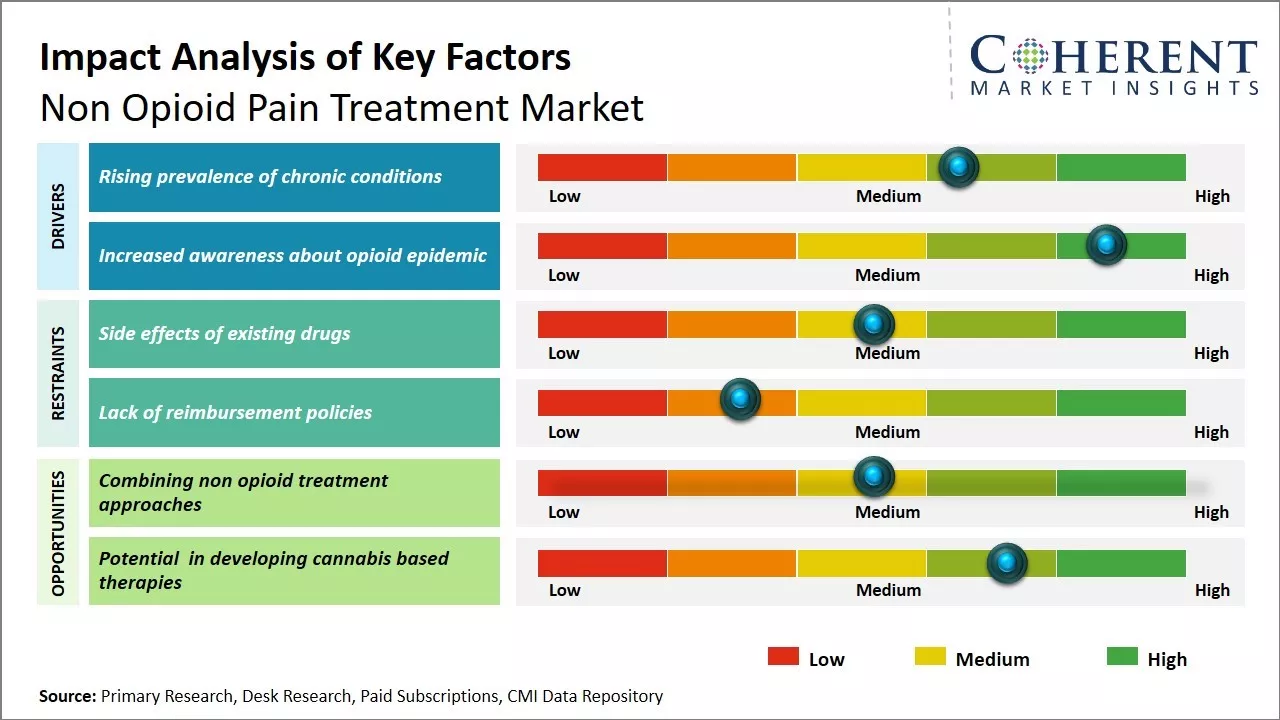
Discover market dynamics shaping the industry: Download Free Sample
Global non opioid pain treatment market is expected to witness positive growth over the forecast period. There is an increased demand for alternative pain therapies owing to the risks and side effects associated with opioid medications. Moreover, growing geriatric population who are more prone to chronic pain conditions like arthritis, and rising awareness about the benefits of non opioid options are some key factors driving the growth of the market. However, high treatment cost of some non opioid therapies and lack of medical reimbursements may hinder the market growth. Overall, advancement in drug delivery technologies and novel product pipeline are expected to bring new opportunities for the market.
Rising Prevalence of chronic conditions
As the population ages, the prevalence of various chronic conditions such as osteoarthritis, lower back pain, and fibromyalgia is rising across regions. Chronic pain leads to a significant reduction in the quality of life as it causes difficulties carrying out routine tasks and disrupts normal sleep patterns. According to a study published in May 2023, by National Institutes of Health, primary agency of the U.S. government that is responsible for biomedical and public health research, new cases of chronic pain are more common among U.S. adults than new cases of diabetes, depression, or high blood pressure. Nearly two-thirds of persons with chronic pain continue to suffer from it a year later. The number of new chronic pain cases was high in 2020, with 52.4 instances per 1,000 people per year. This is in contrast to other frequent chronic illnesses such as diabetes (7.1 cases/1,000 per year), depression (15.9 cases/1,000 per year), and hypertension (45.3 cases/1,000 per year).
Market Concentration and Competitive Landscape
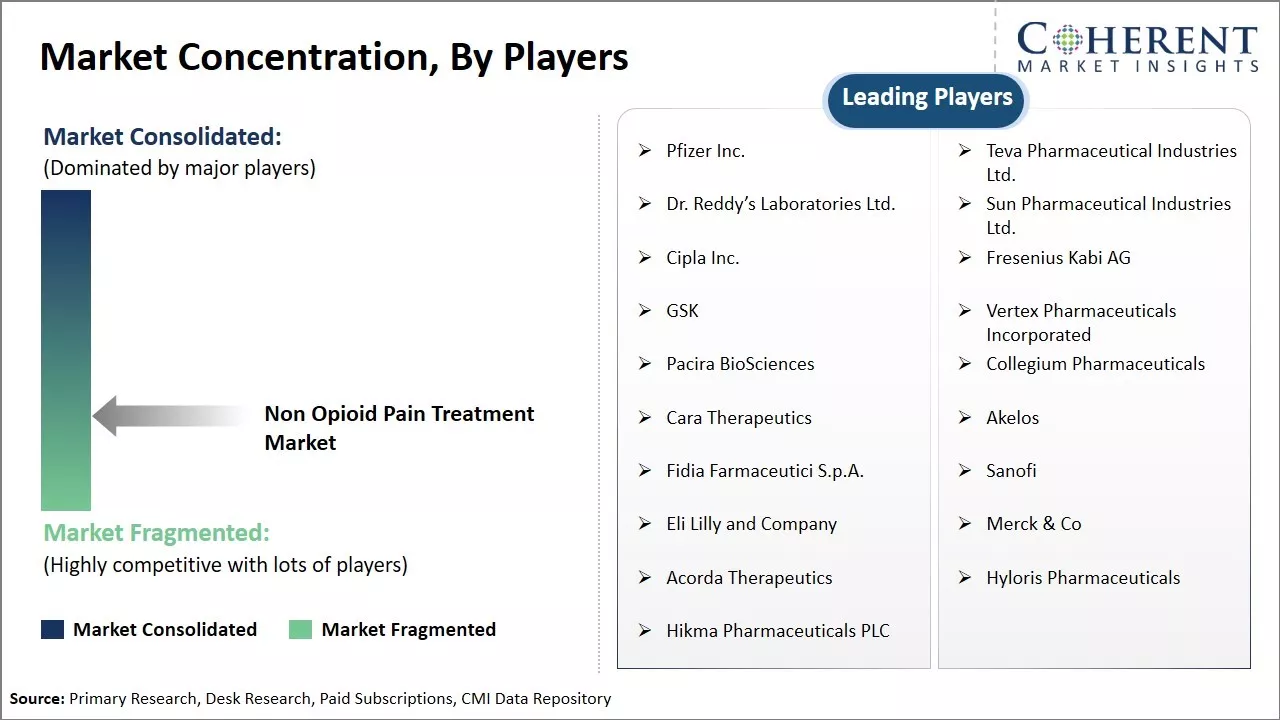
Get actionable strategies to beat competition: Download Free Sample
Increased Awareness about Opioid EpidemicThe ongoing public health crisis arising from misuse and overprescription of opioid medicines in countries like U.S. has brought the drawbacks of opioids under intense global scrutiny. Various entities ranging from public health organizations to governments are engaged in initiatives aimed at curbing inappropriate usage of these highly addictive drugs. At the same time, educational programs are being conducted to spread awareness among patients and medical practitioners about risks of long term use of opioids, alternative treatment options and importance of achieving an optimal pain treatment regimen. For instance, in August 2023, On International Overdose Awareness Day, the Biden-Harris administration announced August 27–September 2 as Overdose Awareness Week to draw attention to the damage caused by illicit fentanyl and other drugs. The White House Office of National Drug Control Policy will invest an additional US$ 1 Mn in its Real Deal on Fentanyl campaign with the Ad Council. The initiative tries to reach out to young people, who are the fastest-growing age group in the U.S. for opioid overdoses.
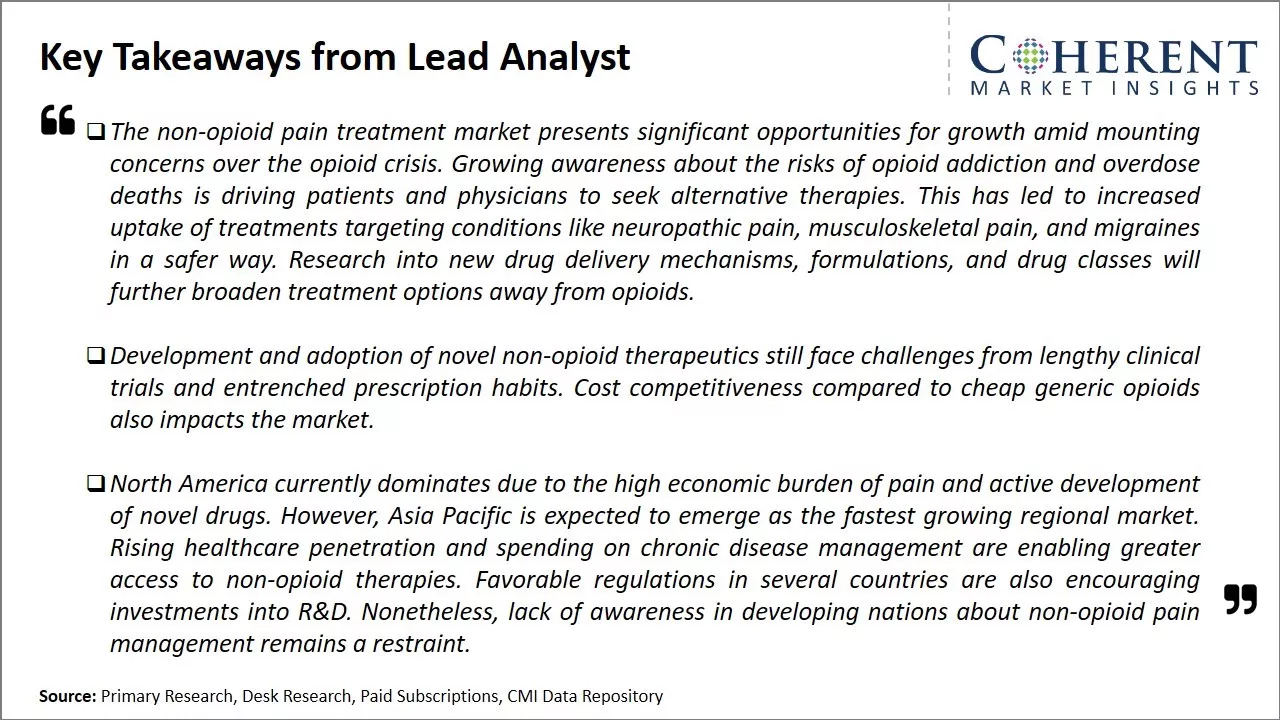
To learn more about this report, Download Free Sample
Market Challenges – Side effects of existing drugsSide effects of existing non-opioid drugs is posing major challenges for the growth of non-opioid pain treatment market. NSAIDs, which are the most common form of non-opioid painkillers available, are associated with increased risk of gastrointestinal, kidney and cardiovascular side effects on long term use. NSAIDs can cause issues like gastritis, ulcers and in severe cases gastrointestinal bleeding. These also exacerbate existing kidney problems in many individuals. Long term use of some NSAIDs has been linked to increased chance of cardiovascular diseases like heart attacks and strokes, according to the data from the National Center for Biotechnology Information published in October 2020.
Market Opportunities - Combining non opioid treatment approaches
Postoperative and cancer pain management remain two areas that present major unmet needs in pain treatment. At the same time, pain is one of the most common and distressing symptoms experienced by cancer patients, with over 90% of advanced stage cancer patients battling pain. However, opioid treatment continues to be the standard of care for managing both postoperative and cancer pain despite the growing crisis of opioid addiction and overdose deaths. This presents a massive opportunity for non-opioid pain therapies to take the lead in treating these underserved patient populations.
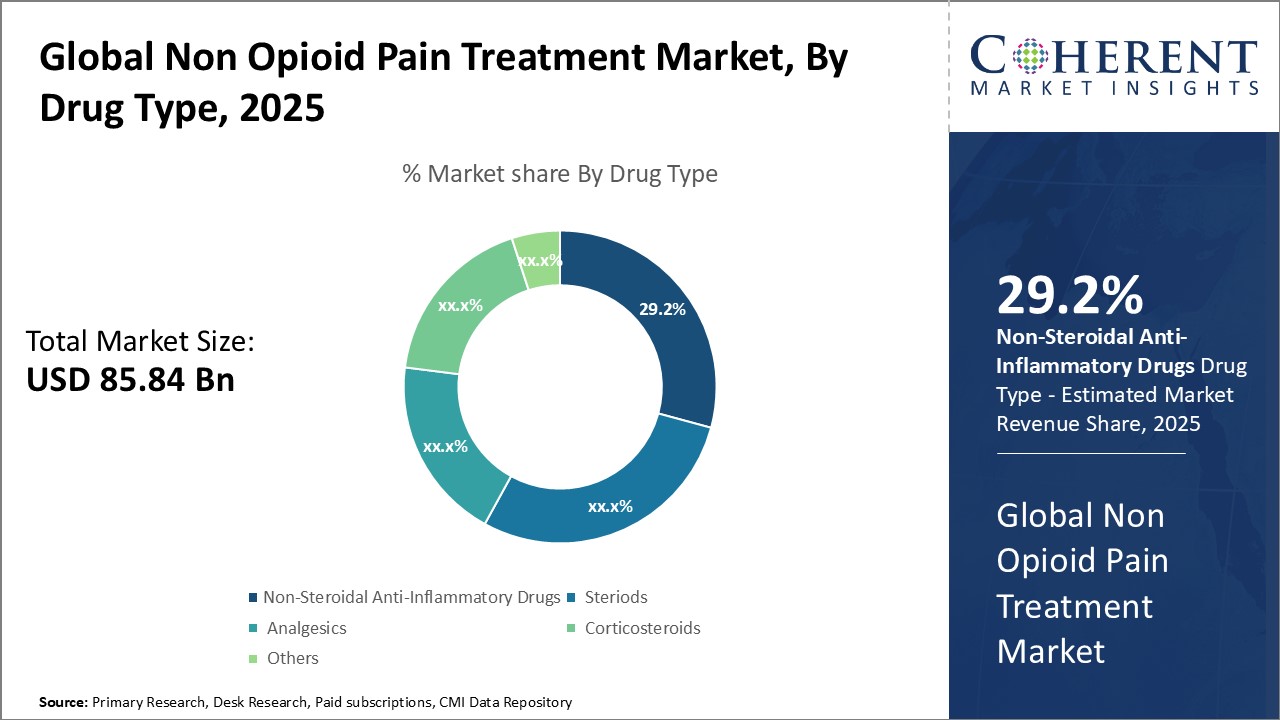
Discover high revenue pocket segments and roadmap to it: Download Free Sample
Insights, By Drug Type, Widespread availability boosts NSAID dominanceThe drug type segment includes, non-steroidal anti-inflammatory drugs, steriods, analgesics, corticosteroids, and others. Non-steroidal anti-inflammatory drugs segment contributes the highest share of the market owing to their widespread availability, proven effectiveness, and ability to treat a variety of pain conditions. This segment is anticipated to account for 29.2% of the market share in 2025. NSAIDs work by blocking cyclooxygenase (COX) enzymes and inhibiting prostaglandin synthesis, thereby reducing inflammation and pain. Ibuprofen, naproxen, and celecoxib are some of the most commonly prescribed NSAIDs. Their mechanism of action has been well-researched over decades of clinical use, establishing them as a front-line treatment for mild to moderate acute pain.
Moreover, NSAIDs are available over-the-counter in many countries without a prescription, making them highly accessible and affordable treatment options. This accessibility has helped NSAIDs garner larger market share as compared to other drug types like analgesics or corticosteroids that often require a prescription. NSAID segment is expected to continue leading the drug type segment owing to generic availability and increased adoption in developing regions with limited access to costlier therapies.
Insights, by indication, chronic pain is the largest indication segment
The indication segment includes musco skeletal disorders, central nervous system disorders, traumatic pain, chronic pain, and others. Chronic pain segment contributes the highest share of the market accounting for 31.9% of the market share in 2025. Chronic pain can result from illnesses like arthritis, back injuries, cancer, or neurological disorders. It persists for months or even years beyond the expected healing time. As opposed to acute pain serving an important biological purpose, chronic pain becomes pathological and disproportionate to the original cause of injury or illness. An aging population and rise in chronic lifestyle diseases have significantly increased the incidence of chronic pain worldwide in recent decades.
Insights, by distribution channel, ease of availability drives retail pharmacies segment
The distribution channel segment includes Online Pharmacies, Retail Pharmacies and Hospital Pharmacies. Retail pharmacies segment contributes the highest share of the market owing to their widespread accessibility and front-line role in dispensing drug therapies. This segment is estimate to hold 38.3% market share in 2025. Retail pharmacies outnumber hospital and online counterparts in most developing markets that account for the bulk of non-opioid analgesic demand. Most patients initiate treatment for mild-to-moderate pain via an over-the-counter purchase or doctor's prescription at a local retail store. Retail pharmacies also leverage familiarity within neighborhoods to drive compliance via counseling and monitoring pain management regimens over extended durations.
Regional Insights
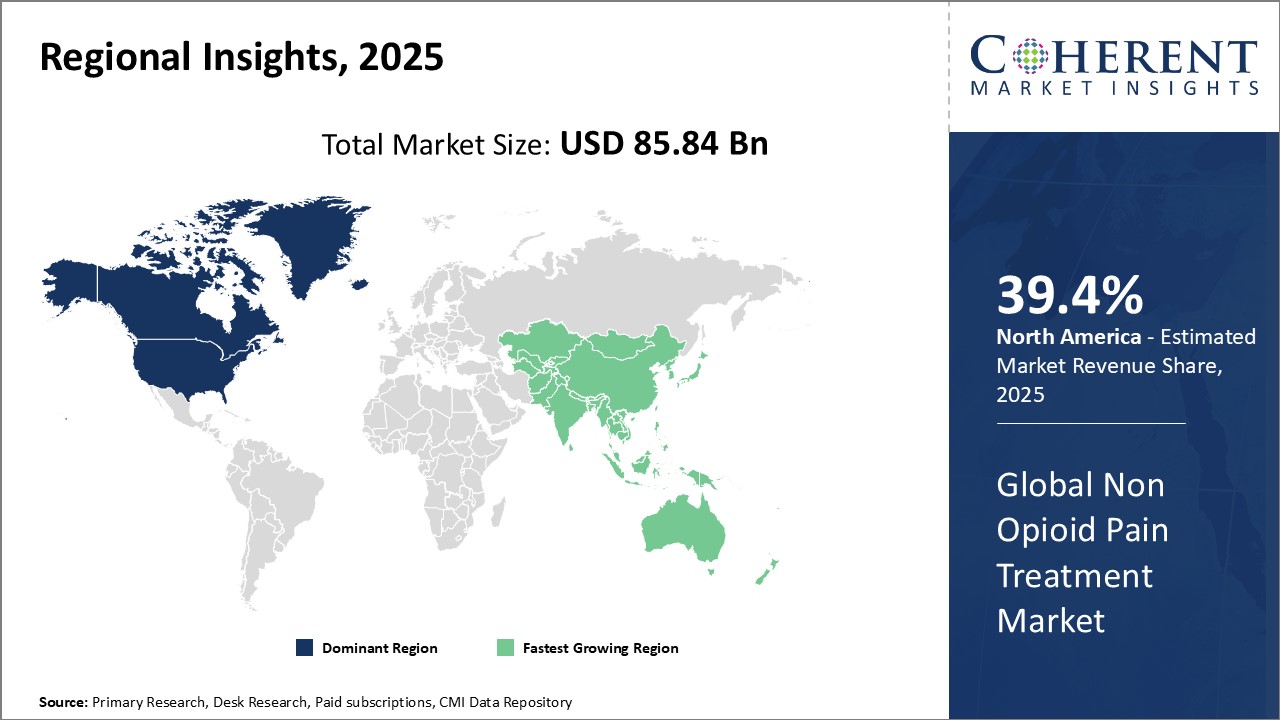
Need a Different Region or Segment? Download Free Sample
North America has dominated the non-opioid pain treatment market owing to focus on alternative pain management therapies. North America is anticipated to hold 39.4% of the market share in 2025. The large healthcare expenditure along with widespread availability and adoption of new treatment options has driven the North American market. The presence of major players and availability of advanced technologies allow patients easy access to novel treatment modalities. Moreover, the growing geriatric population susceptible to chronic pain contributes to the growth in the region.
Asia Pacific has emerged as the fastest growing regional market for non opioid pain treatment. Countries like China and India offer immense potential with their large population bases undergoing rapid urbanization. Growing medical tourism coupled with increased discretionary spending on healthcare is boosting the APAC market growth. Various initiatives by governments aim to strengthen healthcare infrastructure and focus on preventive care rather than symptomatic treatments alone. This encourages use of non-opioid alternatives for pain management.
Europe has also witnessed steady growth in demand for non-narcotic therapies. Stringent regulations have limited the usage of opioids, driving the need for safer options. Countries such as Germany and U.K are high-value markets in the region attributable to sophisticated buyers and advanced medical technologies. The region witnesses a favorable reimbursement scenario along with supportive healthcare policies promoting alternative treatment adoption.
Market Report Scope
Global Non Opioid Pain Treatment Market Report Coverage
| Report Coverage | Details | ||
|---|---|---|---|
| Base Year: | 2024 | Market Size in 2025: | USD 85.84 Bn |
| Historical Data for: | 2020 To 2024 | Forecast Period: | 2025 To 2032 |
| Forecast Period 2025 to 2032 CAGR: | 8.8% | 2032 Value Projection: | USD 155.01 Bn |
| Geographies covered: |
|
||
| Segments covered: |
|
||
| Companies covered: |
Pfizer Inc., Teva Pharmaceutical Industries Ltd., Dr. Reddy’s Laboratories Ltd. , Sun Pharmaceutical Industries Ltd. , Cipla Inc. , Fresenius Kabi AG , GSK, Vertex Pharmaceuticals Incorporated, Pacira BioSciences, Collegium Pharmaceuticals, Cara Therapeutics, Akelos, Fidia Farmaceutici S.p.A. , Sanofi , Eli Lilly and Company, Merck & Co, Acorda Therapeutics, Hyloris Pharmaceuticals, Hikma Pharmaceuticals PLC |
||
| Growth Drivers: |
|
||
| Restraints & Challenges: |
|
||
Uncover macros and micros vetted on 75+ parameters: Get instant access to report
Global Non Opioid Pain Treatment Industry News
- On February 05, 2024, Hikma Pharmaceuticals PLC, a multinational pharmaceutical company, announced the launch of COMBOGESIC IV (acetaminophen and ibuprofen) injection in the U.S. COMBOGESIC IV is an intravenous, opioid-free pain reliever that contains 1,000 mg of acetaminophen and 300 mg of ibuprofen, a nonsteroidal anti-inflammatory drug.
- In December 2023, Vertex Pharmaceuticals, a pharmaceutical company, announced that a non-opioid painkiller significantly reduced pain in diabetic patients suffering from chronic nerve pain in a mid-stage trial, fueling efforts to develop a medication free of the risk of addiction. The research looked at the medicine VX-548 in individuals who had diabetic peripheral neuropathy, a kind of nerve damage caused by high blood sugar.
- In October 2023, Hyloris Pharmaceuticals, a Belgium based pharmaceutical company, announced the approval of a potent non-opioid painkiller in the U.S. Maxigesic IV's New Drug Application (NDA) had been authorized by the U.S. Food and Drug Administration (FDA) for the treatment of mild-to-moderate pain and as an additional therapy for moderate to severe pain
- In February 2020, GlaxoSmithKline, a pharmaceutical company, announced that the US FDA has approved Voltaren Arthritis Pain (diclofenac sodium topical gel, 1% (NSAID)-arthritis pain reliever) as an over-the-counter (OTC) product for the temporary relief of arthritis pain in the hand, wrist, elbow, foot, ankle, or knee in adults (18 years and older).
*Definition: Non opioid pain treatment market consists of pharmaceutical products that provide relief from pain without the use of opioid drugs. This includes alternatives to opioid medications for targeting acute and chronic pain such as neuropathic pain, back pain, arthritis pain, and other pain conditions. Some common non-opioid pain treatments include topical creams, patches, gels and lotions containing medications like lidocaine or capsaicin; oral medications containing acetaminophen, NSAIDs or anticonvulsant drugs
Market Segmentation
- Drug Type Insights (Revenue, USD Bn, 2020 - 2032)
- Non-Steroidal Anti-Inflammatory Drugs
- Steriods
- Analgesics
- Corticosteroids
- Others
- Indication Insights (Revenue, USD Bn, 2020 - 2032)
- Musco Skeletal Disorders
- Central Nervous System Disorders
- Traumatic Pain
- Chronic Pain
- Others
- Route Of Administration Insights (Revenue, USD Bn, 2020 - 2032)
- Topical
- Intravenous
- Oral
- Distribution Channel Insights (Revenue, USD Bn, 2020 - 2032)
- Online Pharmacies
- Retail Pharmacies
- Hospital Pharmacies
- Regional Insights (Revenue, USD Bn, 2020 - 2032)
- North America
- U.S.
- Canada
- Latin America
- Brazil
- Argentina
- Mexico
- Rest of Latin America
- Europe
- Germany
- U.K.
- Spain
- France
- Italy
- Russia
- Rest of Europe
- Asia Pacific
- China
- India
- Japan
- Australia
- South Korea
- ASEAN
- Rest of Asia Pacific
- Middle East
- GCC Countries
- Israel
- Rest of Middle East
- Africa
- South Africa
- North Africa
- Central Africa
- North America
- Key Players Insights
- Pfizer Inc.
- Teva Pharmaceutical Industries Ltd.
- Dr. Reddy’s Laboratories Ltd.
- Sun Pharmaceutical Industries Ltd.
- Cipla Inc.
- Fresenius Kabi AG
- GSK
- Vertex Pharmaceuticals Incorporated
- Pacira BioSciences
- Collegium Pharmaceuticals
- Cara Therapeutics
- Akelos
- Fidia Farmaceutici S.p.A.
- Sanofi
- Eli Lilly and Company
- Merck & Co
- Acorda Therapeutics
- Hyloris Pharmaceuticals
- Hikma Pharmaceuticals PLC
Share
Share
About Author
Vipul Patil is a dynamic management consultant with 6 years of dedicated experience in the pharmaceutical industry. Known for his analytical acumen and strategic insight, Vipul has successfully partnered with pharmaceutical companies to enhance operational efficiency, cross broader expansion, and navigate the complexities of distribution in markets with high revenue potential.
Missing comfort of reading report in your local language? Find your preferred language :
Transform your Strategy with Exclusive Trending Reports :
Frequently Asked Questions
EXISTING CLIENTELE
Joining thousands of companies around the world committed to making the Excellent Business Solutions.
View All Our Clients
